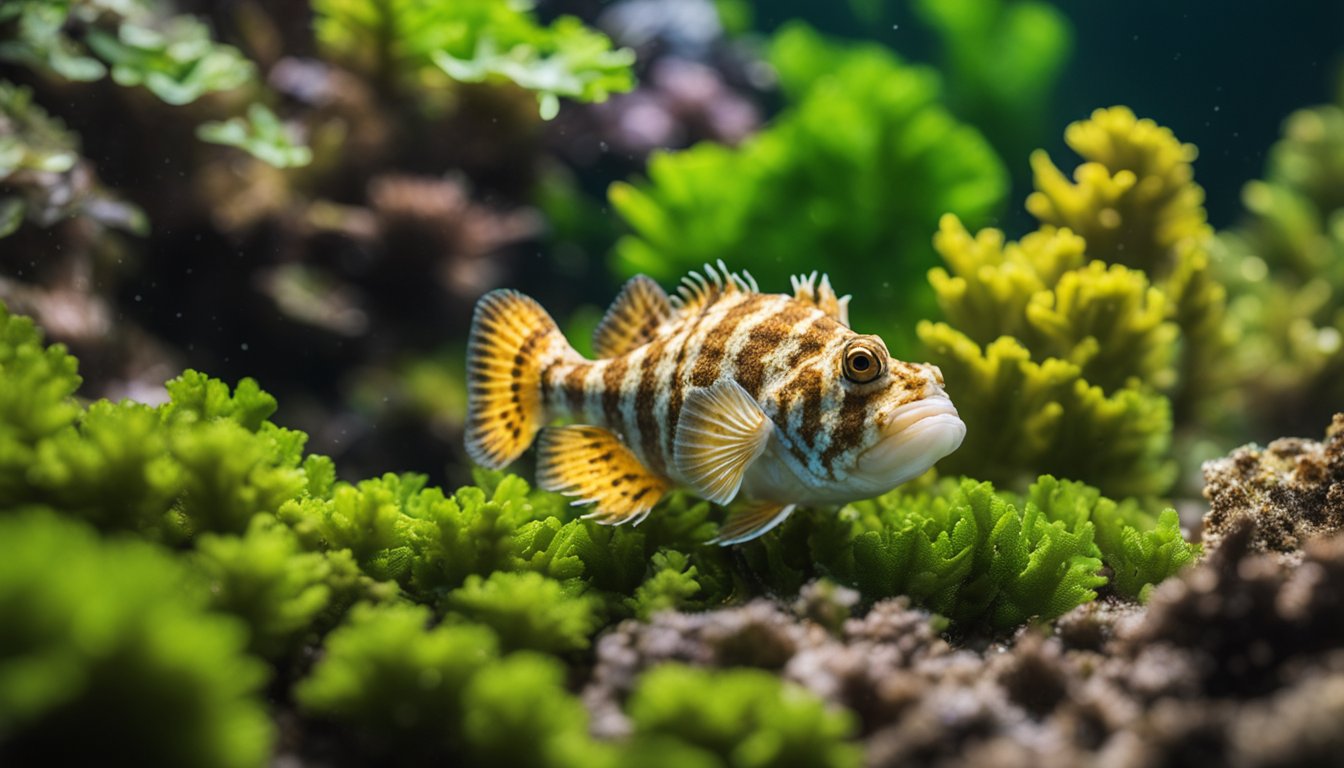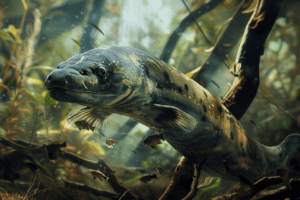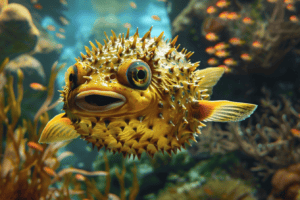Hidden in Plain Sight: The Camouflage Masters, Leaf Scorpionfish

In the depths of the ocean, there are countless creatures that have evolved to blend in with their surroundings.
One of the most impressive of these camouflage masters is the leaf scorpionfish.
This small, but deadly fish is almost impossible to spot, even for the most experienced divers.
At first glance, the leaf scorpionfish appears to be just another piece of coral or seaweed.
Its body is covered in spines and bumps that mimic the texture of its surroundings.
Its coloration ranges from bright red to dull brown, depending on the environment it inhabits.
The leaf scorpionfish is so well-camouflaged that it can sit motionless for hours, waiting for prey to swim by.
Despite its small size, the leaf scorpionfish is a fearsome predator. It has a large mouth and sharp teeth that it uses to ambush unsuspecting fish.
Its venomous spines can cause intense pain and even paralysis in humans.
While the leaf scorpionfish may be small, it is a force to be reckoned with in the underwater world.
The Art of Camouflage
Leaf scorpionfish are masters of camouflage, blending seamlessly into their surroundings to avoid detection by predators and prey alike.
Their ability to disappear into their environment is nothing short of remarkable, and it is a skill that has evolved over millions of years.
Masters of Disguise
The leaf scorpionfish has a remarkable ability to mimic its surroundings, changing its color and texture to match the coral, rocks, or sand on which it rests.
This allows the fish to blend in seamlessly with its environment, making it almost invisible to predators and prey alike.
To achieve this level of camouflage, the leaf scorpionfish has developed a number of specialized adaptations.
Its skin is covered in small, bumpy protuberances that help to break up its outline, making it harder to spot.
It also has the ability to change the color of its skin to match its surroundings, thanks to specialized pigment cells called chromatophores.
Adapting to the Environment
Leaf scorpionfish are found in a wide range of habitats, from shallow coral reefs to deep, rocky outcroppings.
To survive in these diverse environments, they must be able to adapt their camouflage to match their surroundings.
In shallow water, for example, the leaf scorpionfish may take on a bright yellow or orange coloration to blend in with the surrounding coral.
In deeper water, where there is less light, it may adopt a darker coloration to match the rocks and sand on the sea floor.
Overall, the art of camouflage is a remarkable adaptation that has allowed the leaf scorpionfish to survive and thrive in some of the most challenging environments on earth.
Whether blending in with the coral reefs of the tropics or the rocky outcroppings of the deep sea, these masterful camouflagers are a true wonder of the natural world.
Leaf Scorpionfish Basics

Leaf Scorpionfish, scientifically known as Taenianotus triacanthus, is a fascinating and mysterious creature that belongs to the family Scorpaenidae.
These fish are masters of camouflage, blending seamlessly into their surroundings, making them difficult to spot.
Distinctive Features
Leaf Scorpionfish are small in size, typically reaching a maximum length of 14 cm.
They have a flattened body, which is covered in small, leaf-like appendages that help them blend in with their environment.
These fish come in a range of colors, including red, yellow, orange, and brown, allowing them to adapt to different backgrounds.
One of the most distinctive features of the Leaf Scorpionfish is its venomous spines.
They have three spines on their dorsal fin, which can cause a painful sting if touched.
These spines are used for self-defense and are not aggressive towards humans.
Habitat and Distribution
Leaf Scorpionfish can be found in the Indo-Pacific region, including the Red Sea, the coast of East Africa, and the Hawaiian Islands.
They prefer to live in shallow waters, typically between 3 to 30 meters deep, and can be found near coral reefs, rocky outcrops, and sandy bottoms.
These fish are solitary creatures, and they spend most of their time hiding in plain sight, waiting for their prey to come to them.
They are carnivorous and feed on small fish and crustaceans.
In conclusion, the Leaf Scorpionfish is a fascinating creature that has adapted to its surroundings in a remarkable way.
Their unique camouflage and venomous spines make them stand out in the world of marine life.
Behavioral Patterns

Leaf scorpionfish are masters of camouflage and their behavioral patterns play a crucial role in their survival in the wild.
Hunting Techniques
These fish are ambush predators, patiently waiting for their prey to come to them.
They use their incredible camouflage to blend in with their surroundings, perfectly mimicking the appearance of a leaf or piece of algae.
When prey comes within striking distance, the leaf scorpionfish quickly opens its large mouth and sucks in its prey with lightning-fast speed.
Reproduction and Life Cycle
Leaf scorpionfish are known for their unique mating behavior.
During mating season, males will turn a bright yellow color and begin to perform a courtship dance to attract females.
Once a female is found, the pair will engage in a synchronized spawning event, releasing their eggs and sperm into the water column.
After hatching, the larvae go through several stages of development before reaching adulthood.
During this time, they are vulnerable to predators and rely heavily on their camouflage to avoid detection.
Overall, the behavioral patterns of the leaf scorpionfish are fascinating and showcase the incredible adaptability of these creatures in their natural environment.
Conservation Status

The Leaf Scorpionfish is a species that is currently listed as “Least Concern” on the IUCN Red List of Threatened Species.
This indicates that the species is not facing any significant threats to its survival and is abundant in its natural habitat.
However, despite its current status, the Leaf Scorpionfish is still vulnerable to habitat destruction and pollution, which can have a significant impact on its population.
The species is also popular in the aquarium trade, which can lead to overfishing and the depletion of wild populations.
To protect the Leaf Scorpionfish and ensure its long-term survival, it is important to conserve and protect its natural habitat, including coral reefs and rocky areas.
Additionally, efforts should be made to regulate the aquarium trade and prevent overfishing.
By taking these steps, we can help to ensure that the Leaf Scorpionfish remains a thriving and important part of our ocean ecosystems for generations to come.
Frequently Asked Questions

What unique methods do leaf scorpionfish use to blend into their surroundings?
Leaf scorpionfish are masters of camouflage, using their unique appearance to blend seamlessly into their surroundings.
They have a remarkable ability to change their color and texture to match their environment, making them almost invisible to predators and prey alike.
They achieve this by controlling the distribution of pigment cells in their skin, which allows them to match the color and pattern of their surroundings with incredible accuracy.
Is it common to encounter leaf scorpionfish in their natural habitat?
Leaf scorpionfish are found in tropical and subtropical waters throughout the Indo-Pacific region, from the Red Sea and East Africa to Japan and Australia.
While they are relatively common in some areas, they can be difficult to spot due to their excellent camouflage.
They are most commonly found in shallow coral reefs and rocky areas, where they can blend in with the surrounding rocks and coral.
Can you tell me about the typical lifespan of a leaf scorpionfish in the wild?
Leaf scorpionfish typically live for 5-7 years in the wild, although some individuals have been known to live for up to 10 years.
Their lifespan is influenced by a variety of factors, including water temperature, food availability, and predation.
What steps should one take to provide the best care for a leaf scorpionfish in an aquarium setting?
If you are considering keeping a leaf scorpionfish in an aquarium, it is important to provide them with a suitable environment that mimics their natural habitat.
This includes a tank with plenty of hiding places, such as rocks and coral, as well as a sandy substrate.
Leaf scorpionfish are carnivorous and require a diet of small live or frozen foods, such as brine shrimp and krill.
It is also important to maintain good water quality and temperature, as leaf scorpionfish are sensitive to changes in their environment.
What are the main predators of leaf scorpionfish, and how do they avoid them?
Leaf scorpionfish are preyed upon by a variety of predators, including larger fish and octopuses.
To avoid detection, they rely on their excellent camouflage to blend in with their surroundings.
They may also use their venomous spines to deter predators, although they are generally not aggressive and will only use their spines as a last resort.
How does the diet of a leaf scorpionfish change as it grows?
Leaf scorpionfish have a varied diet that changes as they grow.
Juvenile leaf scorpionfish feed primarily on small crustaceans, such as copepods and amphipods.
As they grow larger, they begin to feed on larger prey, such as small fish and shrimp.
Adult leaf scorpionfish are capable of consuming prey that is up to half their own size, making them formidable predators in their own right.









